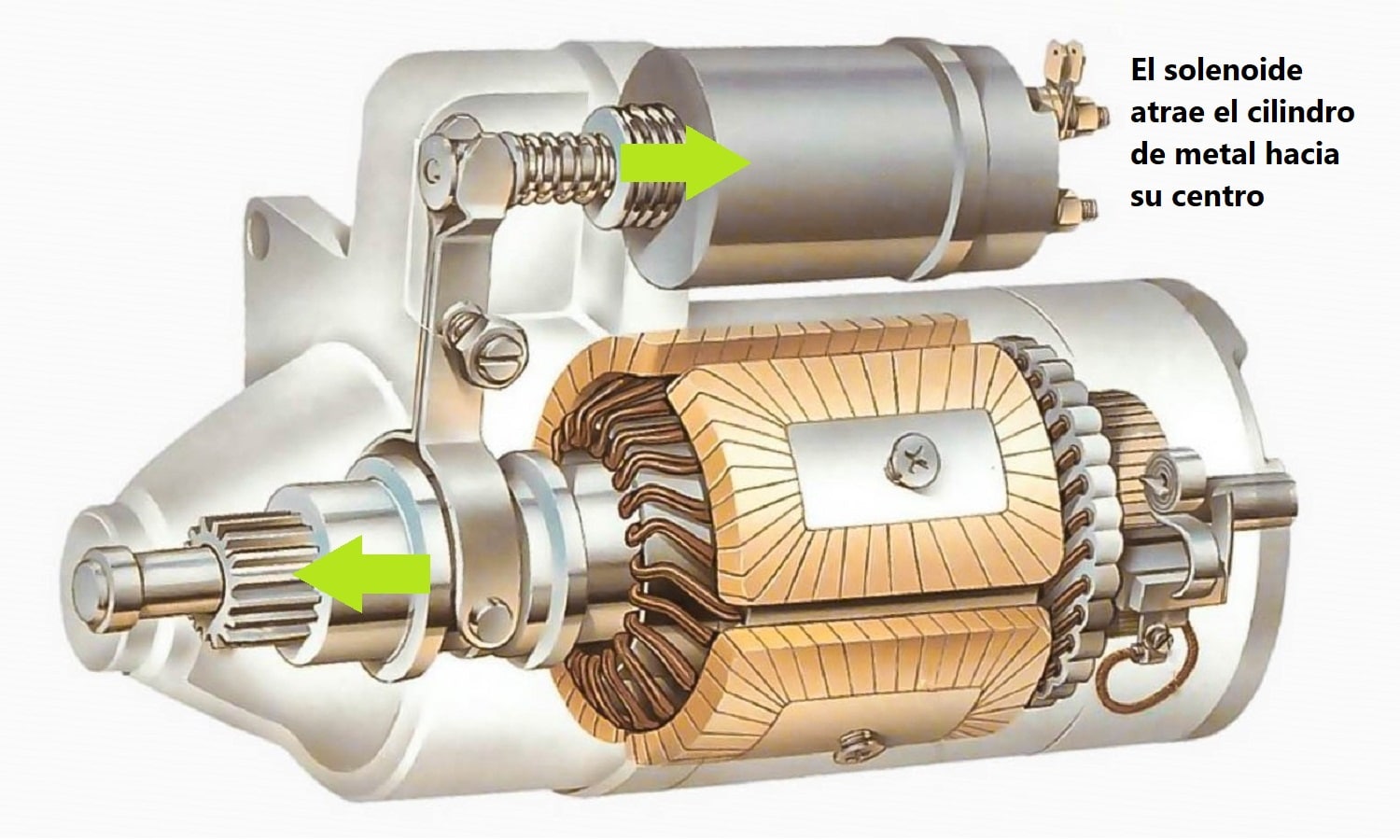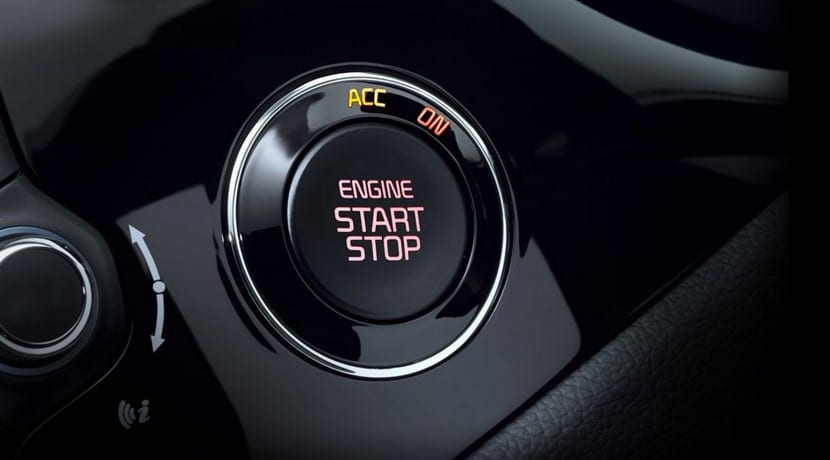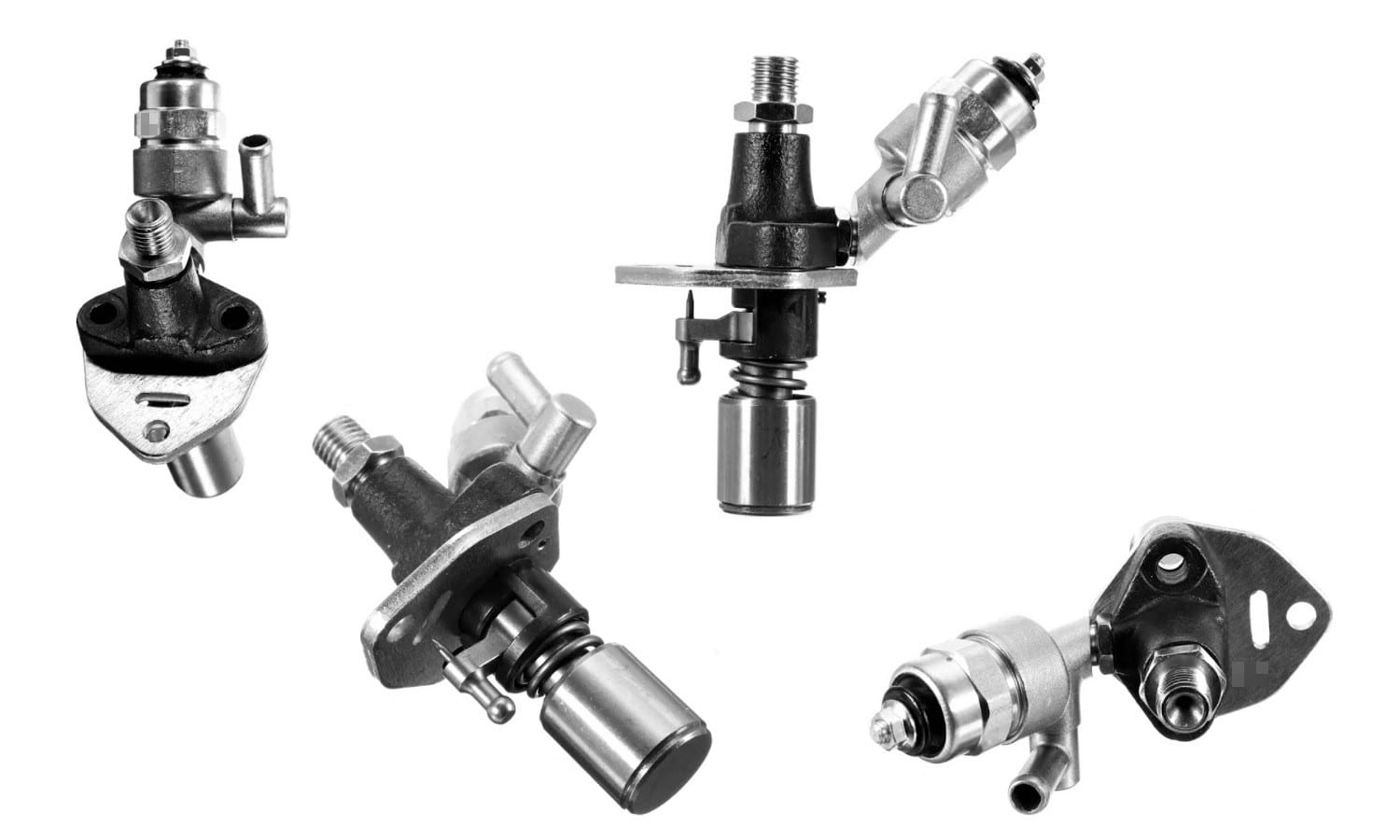
Un solenoid or bobbin is a coiled metallic thread. By passing electric current through it, it generates an electromagnetic field that is often used to attract a metal cylinder to its center. In the car, solenoids are present in many essential parts, such as injectors or electronic fuel pressure regulators.
However, the word solenoid is often used to refer to the one found in the starter, also known as contactor, auto, traction relay, traction solenoid, automotive solenoid or starter relay. It is also sometimes (mistakenly) called Bendix, because it drives the Bendix system.
What is solenoid?

To better understand what a solenoid is, it is good to compare it with a electromagnet. This consists of a thread through which current passes rolled into a piece of metal. In such a way that it achieves the same magnetic field as a magnet.
Well, a solenoid is a electromagnet without iron core. Something that weakens the magnetic field somewhat, but allows what attracts reaches its center. If we place a piece of metal on one of the sides, the solenoid will attract it until it is inside it, as you will be able to see below, in a starter motor.
How does the starter motor solenoid work?
The starter is an element essential for the engine, since it is in charge of starting its rotation thanks to the electric current of the battery. When the crankshaft begins to turn and the cylinders begin their corresponding strokes, the explosions that allow the engine to work on its own are produced. That's where the function of the starter motor ends.

When we turn the ignition key to the start position, we send electrical current from the battery through the contactor to the starter solenoid. This electricity passing through the solenoid of the starter generates a magnetic field that pulls a cylinder to its center. This linear movement is used for two functions:
- Makes the starter can start working because closes the electrical circuit that feeds it, allowing the vehicle to start. In other words, it acts as a relay and comes into contact with two terminals, which are the ones that allow the passage of electric current from the battery (12V) to the electric motor of the starter motor, which is responsible for generating the necessary force to move the flywheel and start the engine.
- Push the drive pinion with a lever that is responsible for pushing the drive pinion of the starter motor and engage it with the teeth of the flywheel (image below).

When we release the ignition key and it goes from the start position to the contact position, electricity stops passing through the starter solenoid, so the magnetic field disappears and all the elements of the starter return to normal. resting position. As you can see in the image, the metal cylinder has a spring that returns it to its place, outside the solenoid.

Solenoid faults in the car
If the starter motor solenoid goes bad the engine will not start.. If the car does not start, it is important to rule out first of all that the battery charge is low or check if the battery is bad. Something you can easily do with a multimeter as indicated in This Video:
If the battery is not the problem, to rule out a solenoid malfunction we can carry out the following test:
- we will need some jump start clips and a battery for testing.
- We will connect the negative of the battery to the housing of the starter motor to obtain the ground.
- With the clamp connected to the positive of the battery, we will gently touch the positive connection terminal of the solenoid, with the intention of closing the circuit and activating only the solenoid, as we would do when trying to start with the ignition key.
- A clack-clack should be heard and if we have the starter removed, we will see how its crown moves forward. If this happens, we can rule out a problem with the solenoid.
- If it does its job when we do this test but not when it's in the vehicle, the problem most likely lies well with the starter cylinder or in the cabling, which may be broken.
In some vehicles, when we turn on the ignition key we will hear a humming noise similar to that of a “mixer”. It is a symptom that the electric starter motor rotates but the solenoid does not work, since what we hear is said motor turning without load.

Fuel pressure regulator solenoid
As you can see, the only thing a solenoid does is achieve a linear movement by attracting a metal bar inside it. This has multiple uses within a car or many other machines. For example, in a electronic fuel pressure regulator, that metal bar is attached to a valve. In such a way that if the solenoid attracts it, it opens the valve to relieve the pressure and protect the injectors.
Naturally, to fulfill this function, the solenoid must be accompanied by a sensor, which measures the pressure of the injection system and a control unit that manages the opening or closing when necessary.

injector solenoids
As its name indicates, in the injectors solenoid valve It is one of these elements that opens and closes a valve to let the fuel pass or not. An operation that harmonizes the Engine Control Unit (ECU according to its acronym in English) according to the needs of the engine.
In a piezoelectric injector this operation is performed an actuator and a ceramic core that expands or contracts with the current passed through it. Which gives it its piezoelectric name. As the expansion in this type of material is extremely fast, it allows more fuel injections per engine cycle. On the other hand, they are three times more expensive than those that work through solenoids.
HELLO, GOOD MORNING…I HAVE A HONDA CRV 97 4X4, WHEN I STOP, THE LIGHT ON (D) BEGINS TO FLASH AND THE GEARBOX DOES NOT ENTER, THEN, I TURN THE CAR OFF AND ON AND AS IT RESET AND IT WORKS AGAIN..I UNDERSTAND THEY ARE THE SELENOIDS, MARK ME THE TWO ABOVE, FRONT PART OF THE RIGHT SIDE, CAN ANYONE TELL ME WHAT THESE SELENOIDS CONTROL, OR SPECIFICALLY HOW I CAN LOOK FOR THEM TO MAKE THE REPAIR… THANKS FOR YOUR HELP
Indeed, in these trucks the most common failure is the solenoid module, these are responsible for opening and closing the flow of oil in the valves, I recommend disconnecting the battery and cleaning the connector terminals, these sometimes get sulfated and yes the problem persists replace the solenoid module I hope this information will help you
good day, I have a 2009 honda crv I did a routine oil and filter service, spark plugs and the next day it turned on in check engine and the letter d flashes and the gas consumption increased considerably, they scanned and selenoids a and b but it does not present any related fault with the automatic transmission. I hope you can guide me on this. Thank you.
Good afternoon.
I have a 1999 Cherokee with a 5200 engine.
The problem I have is that the car is slow to start and it feels like I have the emergency on; however, the car starts and runs fine, it barely has a little more speed after this the changes are not made automatic, it happens almost all the time because sometimes it does.
1. What can this be?
2. What should I do?
and 3. if I use the car like this, can I have consequences?
Thank you so much for your attention
I have an electric motorcycle and I want to know if it is possible to install a solenoid to increase autonomy. At this moment the motorcycle gives me around , between 60 & 65 km. and I need to increase to 120 minimum 100 km. per charge
Thanks for the article, hey Iñigo, I have two questions:
1. Do you know if a solenoid of 36 Volts of DC Auto, is useful for an electric golf cart with 6 batteries of 6V each.
2. It currently uses 6 Trojan 6V batteries which are very high in price, do you know if I can put 3 12V Duralas deep cycle batteries in it?
Thank you very much
Jose Gonzalez